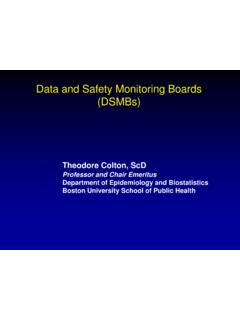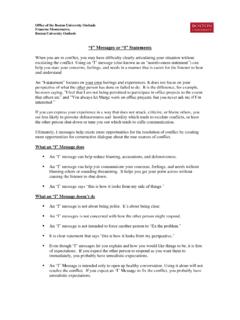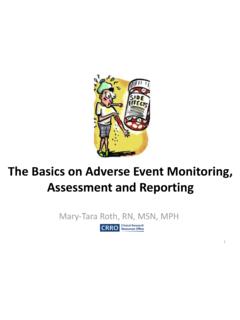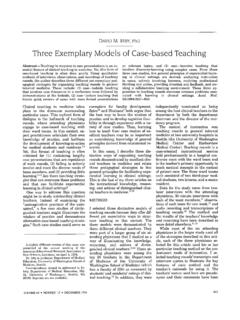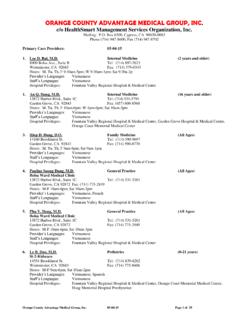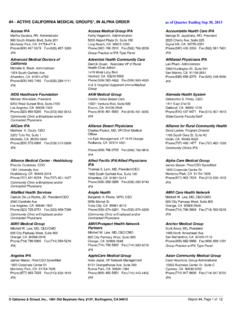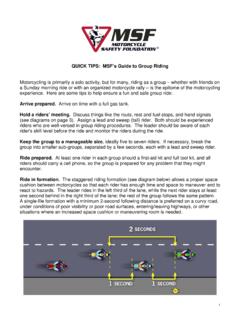Transcription of Small group methods in medical teaching - Boston University
1 459 medical EDUCATION 1997, 31, 459 464 1997 Blackwell Science Ltd Small group methods in medical teaching Henry Walton World Federation for medical Education the contrary. The group leader is an expert at active 1 INTRODUCTION. listening, attentive always to the self-esteem of partici- A teaching skill essential for all medical educators is pants, and competent to conduct a group meeting by Small group competence. Lack of it can never have been quite speci c methods which result in an enhancing more damaging: medical teachers have now to promote intellectual experience for all the members.
2 Active learning, for which Small group methods are optimal. The only kind of medical student now needed 2 DEFINITION OF group WORK. is an activated one, equipped for independent lifelong learning and teamwork; current educational innova- By de nition, a group is a number of people interacting tion, such as problem based learning (Walton & in a face-to-face situation. Most classes or lecture Matthews 1989) depends on Small group teaching . audiences are not groups. They contain numerous Small group work is a method for generating free groups, some of which come together informally out- communication between the group leader and the side class hours.
3 Such haphazard group formation can members, and among all the participants themselves. foster some learning (informal peer groups can be very The group leader can make positive use of the differ- valuable educationally). group work, however, sets out ences in knowledge and attitudes among participants, deliberately to generate individual activity as the basis made evident as they interact with each other. Small for interaction among all the participants. A reasoning group work enables participants to gain a great deal process results in a learning group , directed at resolving from their fellows, in a type of communication which the particular tasks set for the group .
4 (Frequently, at cannot take place in a lecture hall (Westberg & Jason conferences notably, socalled workshops are held, with 1996). no speci c assignment or task clearly set, beyond pro- group methods have the particular merit that when vision of a title or label, with little outcome resulting properly used all participants have the opportunity to and regular frustration. Reporting-back sessions not take part, and each can see for themselves the impact of surprisingly are often excruciating.). their views on the other members of the group .
5 It is worth distinguishing between seminars and free Whenever anybody speaks the response evoked is im- discussion groups. A seminar is leader-centred, rather mediately visible, whether it be assent, disagreement or than participant-centred, and the aim in a seminar is disinterest. A group is also, most importantly so, a more speci c: the seminar leader presents the prede- change system: those taking part in the dialogue are in- termined subject and then ensures that it is adequately uenced as they attend to the participants who speak, explored.
6 A seminar, therefore, is a subject-centred the facts being expressed, and the attitudes conveyed, presentation on a de ned topic area. and reconsider their own positions. A free discussion group , on the other hand, is partici- The group leader (tutor, instructor, moderator, pant-centred and requires much more participation chairman, facilitator) is the crucial agent, not present from all members present. The group session generates merely to listen to the views being stated, but respon- its own issues, over and above the initial topic or task or sible for helping the group to identify any errors, mis- problem designated ( the cause of breathlessness, or perceptions or biases of its members.)
7 This is achieved obstructed labour, or haematuria, etc.) and all the by encouraging them to communicate their ideas and to relevant issues arising are then progressively clari ed on correct each others' errors of grasp as these gradually the initiative of the participants themselves. emerge. Only when participants themselves fail to do so The essential component of both these methods is is there need for the leader to step in to provide cor- the interaction among the members of the group , which rective feedback. Minimal intervention characterizes a is not possible if numbers are too large.
8 About eight to competent group leader, but that in no way implies 12 is an optimal number, allowing all the participants to passivity or mere compliance on his or her part. Quite be regularly active. (Inexperienced group leaders are Correspondence: Professor H J Walton, World Federation for medical Education, 38 Blacket Place, Edinburgh EH9 1RL, UK. 460 ME D I C A L ED U C AT I ON 1997, 31, 459 464 1997 Blackwell Science Ltd especially taxed by silent, non-participitative members.) The leader in a learning group must function as a Twenty is perhaps the maximal size which can work catalyst, certainly not as the authority who is imbued effectively.
9 With the answers: it is not his task to solve the problems arising in the course of discussion. The leader has of course to be in control of the session, but by virtue of 3 T E C H N I C AL R E QU I R E M E N T S. expertise in the group process, and not by exercising A suitable room of appropriate size is required. The dominance or pulling rank. The success of Small groups leader's primary obligation is to ensure the essential depends on the leader's use of appropriate skills (Bar- ``housekeeping'', making all the provisions necessary rows 1988, 1994.)
10 For the group to function properly (such as seating, The participants may nd it frustrating, even irritat- warmth, lighting, quiet, security of information, etc.). ing, when the leader abdicates the leading role. In fact, The leader does not sit at a desk or in any other au- when in a phase of passivity a group may be actually thoritative position, but takes his (or her) place on enraged if the leader declines to feed them with facts equal terms with the participants. A round table may be when perplexity arises. (Traditional methods of in- helpful for texts, notebooks and elbows.)
